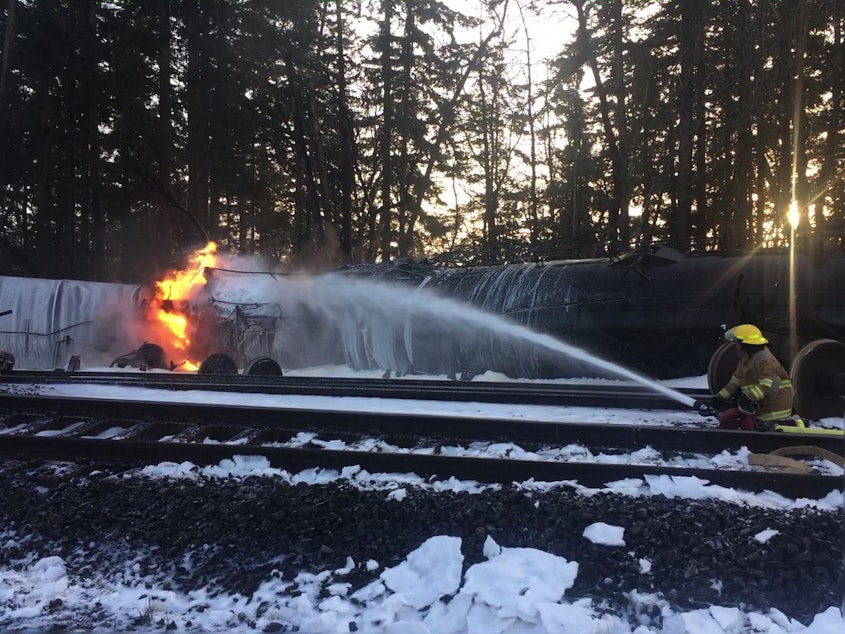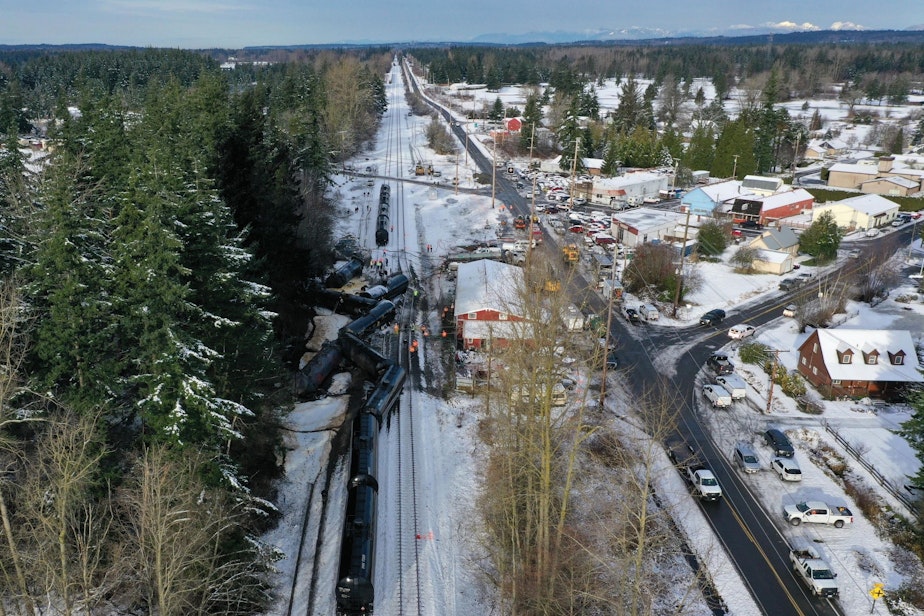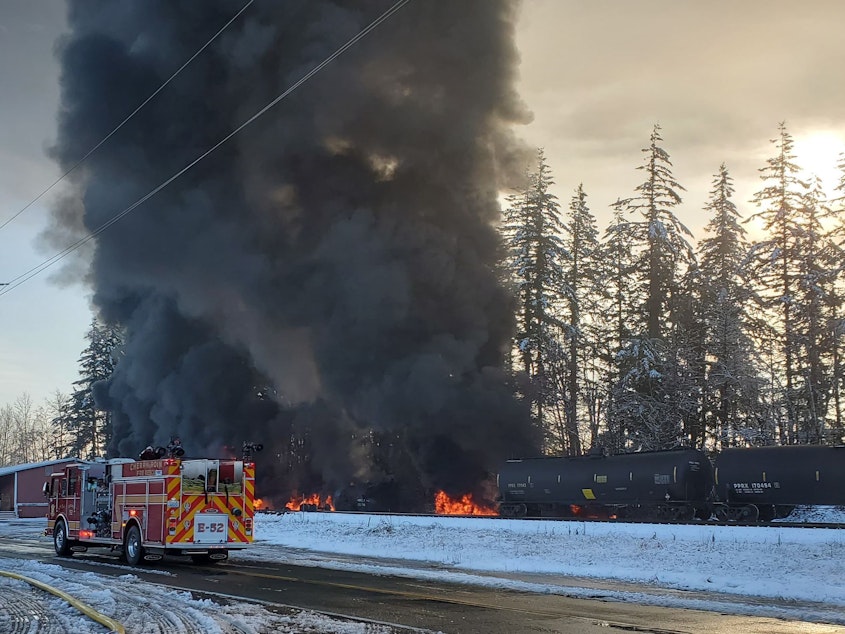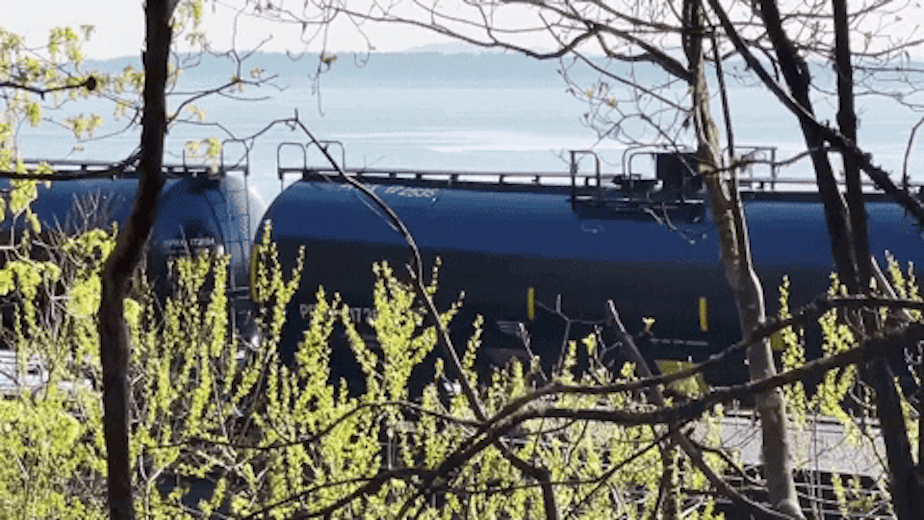Federal investigation points to ‘possible’ sabotage of oil train in Custer crash

Federal investigators say someone apparently tampered with the brakes and couplers on an oil train before it derailed and caught fire north of Bellingham last December.
On top of the apparent tampering, BNSF Railway managers and crew failed to follow their own safety rules around transporting hazardous material, according to a report by the Federal Railroad Administration.
The combination of factors led the mile-long train to split into two pieces, then crash into itself, with 10 tanker cars full of highly flammable Bakken crude oil derailing and three catching fire.
Trains’ failsafe emergency brakes are designed to engage if a train comes apart for any reason, but, as a KUOW investigation found in June, this train’s brakes had been disabled.
“Two angle cocks that appeared to be tampered with were found during the on-site investigation, one partially closed and the other fully closed,” the federal report states.
"Angle cock" is railroad lingo for a brake-line valve. Closing those valves can prevent the pressurized brake line that runs the length of the train from losing pressure — and stop brakes from engaging.
Sponsored
RELATED Read KUOW's three-part investigation into the train crash:
- 'The train is on fire': tense moments after an oil train derailed
- What led to Whatcom oil-train disaster? Investigators eye equipment, tracks, even sabotage
- Sabotage caused Washington oil-train disaster, rail union says
Disclosure: BNSF Railway is a financial supporter of KUOW. The station's financial supporters have no say in our news coverage.
How it went down
The train carrying three million gallons of Bakken crude was on the last leg of a six-day journey from the oil fields of North Dakota to the Phillips 66 refinery in Ferndale.
Sponsored
The long string of oil tankers stopped outside the small town of Custer for a crew change. It sat on the rural tracks before sunrise for about two hours until its Everett-based crew went home at the end of their shift.
Federal rail investigators say the train then sat unattended for three hours before a replacement crew arrived from Blaine.
Those hours sitting on the tracks, according to investigators, left the train’s couplers and brake valves vulnerable to "possible vandalism."
“In both instances, vandals had opportunities to tamper with the couplers and brake-pipe angle cocks,” the report states.
Investigators found nothing to suggest a malfunction of the coupling mechanisms on the two cars that lost their grasp on each other in the run-up to the disaster, “leading the investigation back to the train draft gear coupler being manually manipulated to cause the train to separate.”
Sponsored
The FBI launched a criminal investigation of the incident almost immediately in December 2020. It is unknown whether the agency ever identified any suspects.
One eyewitness reported seeing two men leaving the tracks where the train sat just before it departed and derailed.
According to the Federal Railroad Administration report, the FBI’s criminal investigation of the incident is still open. FBI spokespeople declined to comment.

With a new crew, the train resumed heading north at 11:29 a.m. It derailed 10 minutes and just half a mile later.
Sponsored
In between, security footage from a Bonneville Power Administration electrical substation caught the train’s two halves heading separately north, with a 17-second gap between them.
The train then entered a bowl-like stretch of track before a left turn toward Whatcom County’s two oil refineries. As the front half chugged up and out of the bowl at seven miles an hour, the back half accelerated down into the bowl until it slammed into its front half at 21 miles an hour.

Unsupervised trains, uninformed crews
Russell Quimby, a rail-industry consultant and retired National Transportation Safety Board rail-accident inspector who reviewed the Federal Railroad Administration report at KUOW’s request, said it was “obvious” that this disaster was no accident.
“This wasn't somebody’s mistake or anything,” he said. “It was a purposeful thing.”
Sponsored
“As a minimum, you can call it vandalism. As a maximum, you call it some form of terrorism,” Quimby said. “I really hope that if everybody follows the rules, these kinds of things won't happen in the future.”
The same morning the investigation into the Custer train wreck came out earlier this week, a jury in Seattle found Ellen Reiche of Bellingham guilty of violence against a rail carrier. She faces up to 20 years in prison.
Reiche and co-defendant Samantha Brooks, who pleaded guilty in July and faces sentencing in October, had been arrested late at night on BNSF tracks in Bellingham in November near a newly placed wire shunt — a device aimed at disrupting train signals.
There is no indication that either woman played a role in the Custer disaster.
The federal investigators say BNSF left this train full of three million gallons of hazardous material unattended, illegally.
In August 2013, one month after an exploding oil train killed 47 people in the town of Lac-Mégantic, Quebec, the Federal Railroad Administration issued an emergency order aimed at preventing similar incidents. It required railroads to have a plan listing specific locations and circumstances in which they can leave trains full of hazardous materials without someone watching over them.
The FRA report says BNSF’s plan, as of 2020, lacked those specifics, making it illegal for the company to leave an oil train unattended away from one of its rail yards.
The inquiry into the Custer disaster also finds that BNSF failed to inform its employees of the frequent vandalism on its tracks in Whatcom and Skagit counties in 2020.
“In so doing, BNSF failed to follow their own safety rules to heighten employee awareness about these recurring security threats in the Pacific Northwest,” the report states.
As it was, two BNSF employees — the train's Everett-based engineer and the Blaine-based engineer who replaced him — failed to do what’s called a “train check”: an electronic test of the brakes up and down the mile-long train.
A train check would have detected the disabled brakes and prevented the fiery disaster, according to the report.
BNSF has internally disciplined the latter engineer and let the former off with a warning, according to union officials.
The federal rail agency also ruled out other possible causes of the crash, including track and signal conditions and fatigue or intoxication of the crew.

Washington Rep. Suzan DelBene, whose district includes Custer, said the report sheds light on the incident but leaves questions outstanding, including how to keep Whatcom County safe from future tampering with oil trains.
"I call on BNSF to take greater actions to address the safety concerns outlined in the report and for the federal government to get us answers," DelBene said in an email.
BNSF spokesperson Lena Kent declined to be interviewed and declined to comment on the findings of the Federal Railroad Administration’s 19-page report.
“We will carefully review this report and make adjustments to our operations, training and employee communications as appropriate,” Kent said in an email Thursday afternoon.
“I can guarantee you they've already reviewed it,” Quimby said when informed of BNSF’s response. “The legal department at this point is probably, pending any kind of lawsuits or anything, is probably advising them to keep quiet.”
Earlier this year, BNSF reported to the Pipeline and Hazardous Materials Safety Administration that the Custer disaster did $855,000 in damage to the train and tracks and spilled or burned $34,000 worth of crude oil. It estimated that the emergency response cost $500,000 and oil-spill cleanup another $250,000. The cost estimates do not account for any environmental, health, or other disruptions from the disaster.
First responders evacuated 120 people from Custer and shut down Interstate 5 for four hours to keep people away from the thick black smoke and possible explosions. The oil fires burned for more than seven hours before being extinguished.
No injuries were reported from the crash and fire. State officials said the region got lucky that the oil spilled and burned far from any major population centers, salmon streams, or other water bodies.
This story has been updated with comments from Rep. Suzan DelBene.





